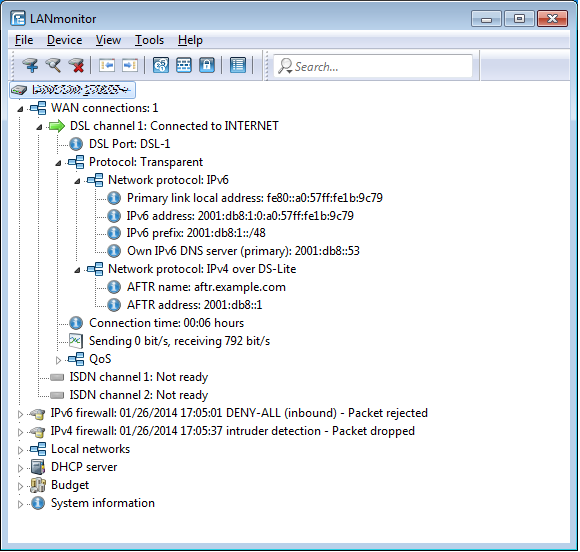Dual-Stack Lite, abbreviated DS-Lite, is used so that Internet providers can supply their customers with access to IPv4 servers over an IPv6 connection. That is necessary, for example, if an Internet provider is forced to supply its customer with an IPv6 address due to the limited availability of IPv4 addresses. In contrast to the other three IPv6 tunnel methods "6in4", "6rd" and "6to4", DS-Lite is also used to transmit IPv4 packets on an IPv6 connection (IPv4 viaIPv6 tunnel).
For this, the router packages the IPv4 packets in an IPv4-in-IPv6 tunnel and transmits them unmasked to the provider, who then performs a NAT with one of their own remaining IPv4 addresses.
To define a DS-Lite tunnel, all the router needs is the IPv6 address of the tunnel endpoint and the routing tag with which it can reach this address.
By default, the router uses the IPv4 address of the corresponding internal network, e.g., from "INTRANET". If you would like to define a different IP address instead (e.g., 192.0.0.2), it must be entered in the IP parameter list along with the remote site name of the DS-Lite tunnel.
Entering an IPv4 DNS server is not recommended for a DS-Lite tunnel, since its entries would unnecessarily fill the NAT table of the Internet provider.
You set up a DS-Lite tunnel in LANconfig via by clicking on DS-Lite tunnel.

Then click on the Add button and enter the designation of the tunnel, the IPv6 address of the gateway, and the routing tag.

- Name of the tunnel
- This entry determines the name of the IPv4-over-IPv6 tunnel.
- Gateway address
- This entry defines the address of the DS-Lite gateway, the so-called Address Family Transition Router (AFTR).
The following values are possible:
- One IPv6 address (e.g. 2001:db8::1)
- An FQDN (Fully Qualified Domain Name) that can be resolved by DNS, e.g., aftr.example.com
- The IPv6 unspecified address "::" determines that the device should retrieve the address of the AFTRs via DHCPv6 (factory setting).
- An empty field behaves the same as the entry "::".
- IPv6 routing tag
- The routing tag uniquely specifies the route to the DS-Lite gateway.
The status table and the number of current DS-Lite connections can be shown using LANmonitor:
